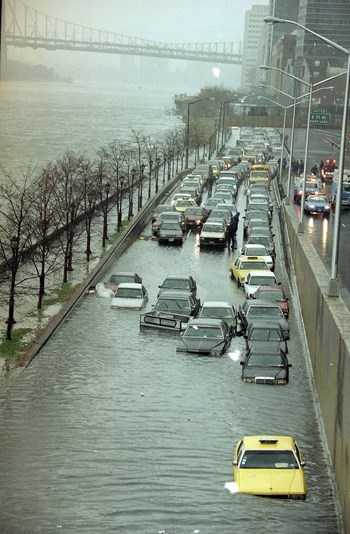
Time was when the average New Yorker didn’t think much about floods. Sure, there were severe storms here, such as the infamous Hurricane of 1938 that hit Long Island and the Great Nor’easter of 1992, but these were few and far between.
Then came the debate over global warming, and above all, Hurricane Katrina. It seemed like there were more and more floods, and suddenly people began to wonder about the possibility of floods and hurricanes threatening New York. Various government agencies began putting out maps of what parts of the city were vulnerable to storms. In some areas, insurance companies refused to renew homeowners’ policies because the homeowners lived in a “flood zone.” And many people, including condo and co-op owners, began to wonder about flood insurance.
How at-risk is the city when it comes to flooding? It’s hard to say, but floods are the number one disaster in the United States. And remember that much of New York—including large parts of Lower Manhattan—is built on landfill.
“The city actually ranks quite high,” says Alan Lyons, of counsel with the New York City law office of Arent Fox LLP, “Right up there with communities in the Gulf Coast and Mississippi River in the number and dollar value of flood insurance claims paid. New York City has 578 miles of waterfront and ranked third in the number of paid flood insurance claims from Jan. 1, 1978 to July 31, 1983.”
And more recently, readers may remember this past December’s heavy flood in which water from Jamaica Bay flooded onto the Belt Parkway for a couple of hours.
Dan Corbin, director of research for the Professional Insurance Agents of New York (PIANY) says that these are the areas that are most at risk for coastal flooding:
• Bronx:Edgewater Park, Silver Beach, Locust Point, Classon Point and Throggs Neck.
• Brooklyn:Coney Island, Brighton Beach, Manhattan Beach and Sheepshead Bay
• Manhattan:Battery Park City, South Street Seaport, the Lower West Side, the FDR Drive and the Lower East Side east of Avenue C.
• Queens:The Rockaway Peninsula, Broad Channel, Howard Beach, West Hamilton Beach.
• Staten Island:New Dorp Beach, Oakwood Beach, Foxwood Beach, Great Kills and Tottenville.
New York City’s Office of Emergency Management (OEM), on its website, has a map of “hurricane evacuation zones,” showing “Zone A” areas (at risk in any hurricane), “Zone B” areas (at risk in a Category 2 and higher hurricane) and “Zone C” areas (at risk in a Category 3 or 4 hurricane, unlikely in New York). To take a look at the specific zones go to the website at: http://www.nyc.gov /html/oem/downloads/pdf/hurricane_map_english.pdf.
It’s hard to quantify risk, according to Alex Seaman, a senior vice president with the Woodbury, Long Island-based HUB International Northeast, but certain parts of Manhattan and areas like the South Shore of Long Island are certainly vulnerable to weather-related storms and flooding as any coastal area is. “That’s tough to say, it’s not for an insurance broker to make that determination but the insurance carriers feel that it’s a very significant risk as several of them have pulled out of the market, especially with respect to personal insurance. A lot of them are not writing any homeowners’ at all. A lot of carriers are not writing any commercial real estate risk so obviously there’s an enormous fear. I guess their projections say it’s just a matter of time before a large storm hits and they don’t have the capacity to handle it.”
The National Flood Insurance Program (NFIP) is the primary source for flood insurance in the United States. Flood insurance can be purchased from a licensed private insurance company or an independent property and casualty insurance agent. If you go to www.floodsmart.gov, you can even type in your address and find what your risk is and estimate your premiums for flood insurance. Happily, this writer’s Manhattan address is listed as “low- to-moderate risk.” If your insurance agent is unfamiliar with the NFIP or is not licensed to sell National Flood Insurance, call NFIP at (888) 379-9531. Even if you live in a low-moderate risk area, the New York City officials recommend that residents consider purchasing flood insurance, especially because water main breaks can also be covered.
Asked about the types of flooding most common in the metro area, Barbara Lynch of the Federal Emergency Management Agency (FEMA) mentions Nor’easters—a type of large storm found on the East Coast, with winds coming from the Northeast—as doing substantial damage. The aforementioned Great Nor’easter of December 1992, which closed LaGuardia Airport and shut down the entire subway system for three hours, was, of course, such a storm.
Not all flooding is caused by such dramatic events. Eric Cohen, a managing partner of Benefit Quest Inc., says flash flooding brought about by thunderstorms or intense rainstorms—where a local street can suddenly become a river—claims more than 140 lives a year.
Flash floods don’t have to occur in coastal areas like Coney Island or the Rockaways. They can happen anywhere. For example, in January 1999, during a record rainstorm, water rose waist-high in parts of Springfield Gardens and a foot deep on the JFK Expressway, and some Queens residents had to be evacuated. Most flash flooding is caused by slow-moving storms.
Flooding can also be caused or exacerbated by clogged or overwhelmed sewers or catch basins, causing water to back up into houses and basements. “When we are notified by the National Weather Service about a significant storm,” says Ira Tannenbaum, coordinator of public and private initiatives at OEM, “we reach out to the DEP (Department of Environmental Protection) and have a process of looking at some of the typically-overwhelmed catch basins in advance.”
Flood Insurance
All this flooding, as we’ve mentioned, makes people think more about flood insurance. But because floods are unpredictable and catastrophic, says Corbin, most insurers in the past deemed it an “uninsurable risk.”
That was one reason why Congress created NFIP back in 1968. The program is administered by FEMA, which works with nearly 90 private insurance companies to serve homeowners, condo owners and renters alike in participating communities. Most flood-hazard areas in New York, and even some that aren’t flood-hazard areas, participate in the program. New York City participates and so do many municipalities in Westchester, Nassau and Suffolk counties.
Flood insurance is mandated for owners who have federally-backed mortgages and whose properties are located in high-flood-hazard areas. But Cohen reminds everyone that one in four flood claims is filed by someone living in a moderate- or low-risk area, so flood insurance is a good investment for property owners and renters regardless. And even in high-flood-risk areas, only about 25 percent of households have flood insurance. The cost of the insurance premium is primarily dictated by the zone designations noted by FEMA, Seaman says.
Who in the co-op and condo community usually buys flood insurance—buildings and associations or individual unit owners?
Condo associations, says Corbin, are typically responsible for insurance coverage for a building. Indeed, NFIP has a special Residential Condominium Building Association Policy.
However, these policies are only for the actual building structure; its foundation; its mechanical and electrical systems; appliances such as refrigerators, stoves and dishwashers; and permanently-installed carpeting. Individual owners are responsible for obtaining flood coverage for the contents of their apartments.
If individual owners do buy flood coverage, says Lyons, it can include clothing, furniture, electronic devices, curtains, window air conditioning, portable microwaves and dishwashers, carpeting that is not already included in property coverage, and clothes washers and dryers.
It does not include currency, valuable papers, cars, patios, decks, damaged caused by mold or any number of other items. These items, however can be covered in other policies.
Do owners on upper floors have as much to worry about as people on the ground or second floor? Lyons says that “owners on upper floors should still purchase flood insurance to protect themselves against having to vacate the building as a result of the building being rendered unstable or uninhabitable due to a flood.”
In a cooperative situation, every shareholder would be required to have flood insurance whether they lived on the first floor or the 30th floor, according to Jeanette Napodano, an assistant vice president with HUB International. Shareholders typically share maintenance costs, so if the lower floors suffered flood damage, owners on the upper floors would bear some of the cost of the repairs. And, says Napadano, most banks/mortgage lenders require it if the homeowner is in a high risk zone.
What Is a Flood?
We’ve now heard about several types of floods. But what constitutes a flood from the definition of insurance?
In the National Flood Insurance Policy’s standard policy, a flood is described, in part, as “a general and temporary condition of partial and complete inundation of two or more acres of normally dry land area of two or more properties (at least one of which is the policyholder’s property) from overflow of inland or tidal waters, from unusual and rapid accumulation of surface waters from any source, or from mudflow.”
Since the NFIP policy covers the “unusual and rapid accumulation or runoff of surface waters,” explains Corbin, there isn’t any coverage without the presence of surface water. Water that accumulates below-ground in the basement isn’t covered—unless it overflows to the extent that it also accumulates on the surface.
Lyons adds that direct physical loss caused directly by sewer backups, discharges or overflows from a pump or seepages or leaks within the property aren’t covered, “unless there is a general condition of flooding in the area and the flood is the primary cause of the sewer or drain backup.” So if, for example, flooding in the area causes a sewer or drain backup, resulting in even more flooding, then that condition would be covered by the policy.
Corbin adds that “when rain enters through wind-damaged window or door, or comes through a hole in a wall or the roof, the NFIP considers the resulting damage to be windstorm-related, not flood-related.”
It’s not only a 100-year storm that can wreak havoc. A sound bit of advice for building managers, says Seaman, is to relocate all electrical equipment and the mechanical or machine rooms that are in the basement to higher floors. This way if there is water damage at ground level, it wouldn’t affect power to the whole building. “It’s a good idea to keep the electrical equipment above ground.”
What To Do?
What should you do if there is a flood and you’re covered by a flood-insurance policy?
One of the first things you should do is to save as many damaged items as possible, make a list of them, and, if possible, photograph them. And you definitely should contact your agent or insurance company or agent to file a claim as soon as possible.
Then, the adjuster will provide you with a Proof of Loss Form. As the insured, you must then file the form with your insurance company within 60 days of the flood. You will receive compensation after an agreement has been reached on the amount of damages.
In the event of major catastrophic flooding, Lyons notes that the process may take longer because there are so many claims being processed.
Experts agree that making a flood claim should not affect one’s future premiums. However, when there are four or more claim payments that exceed $5,000, or two or more claim payments that exceed the current value of the property, the property will be subject to Severe Repetitive Loss requirements of the policy.
So in general, if you want to know more about flood insurance, contact your management company, your insurance broker or your insurance agent. You can also get more details from www.floodsmart.gov.
Raanan Geberer is a freelance writer and editor living in New York City.






2 Comments
Leave a Comment